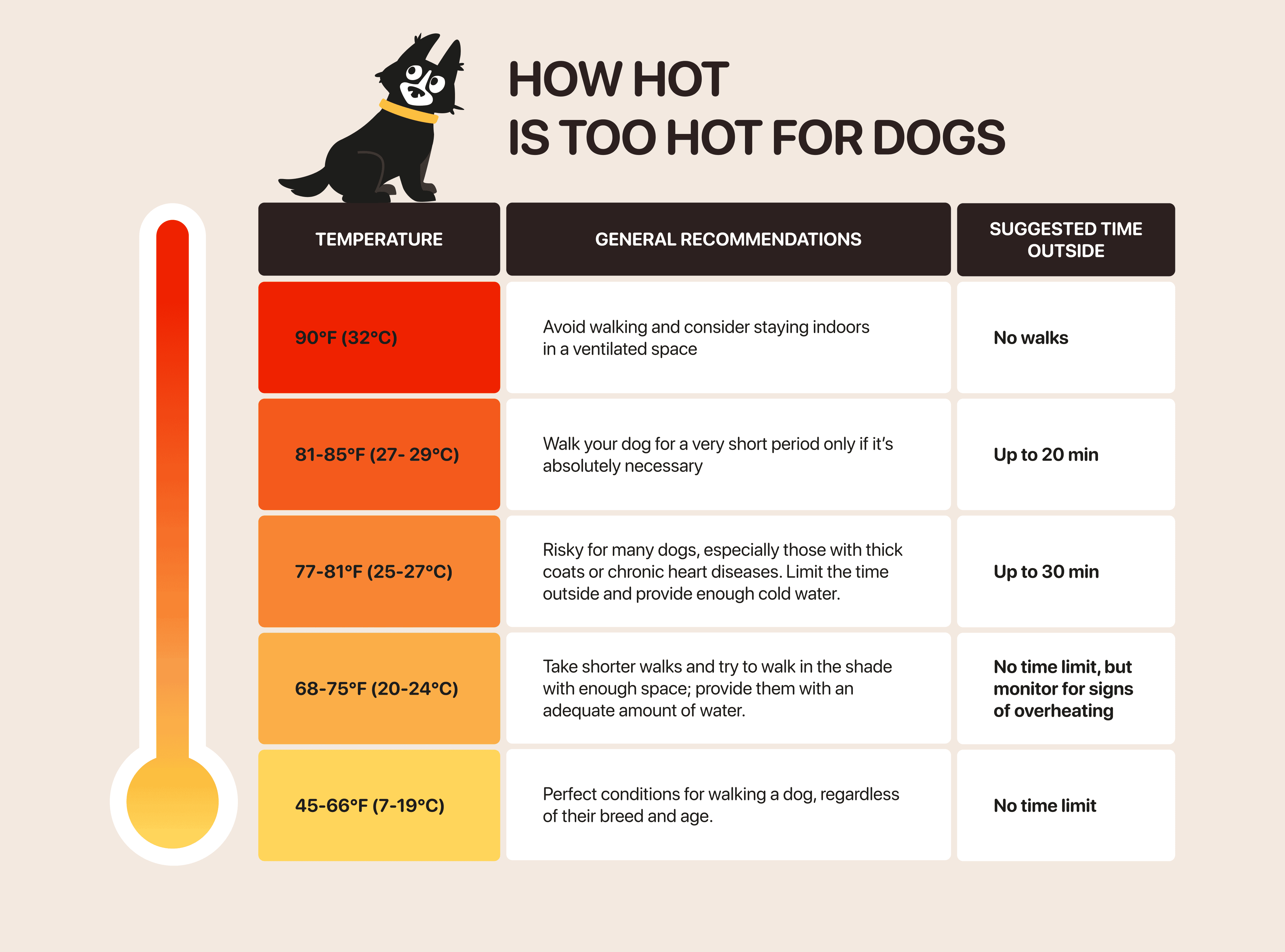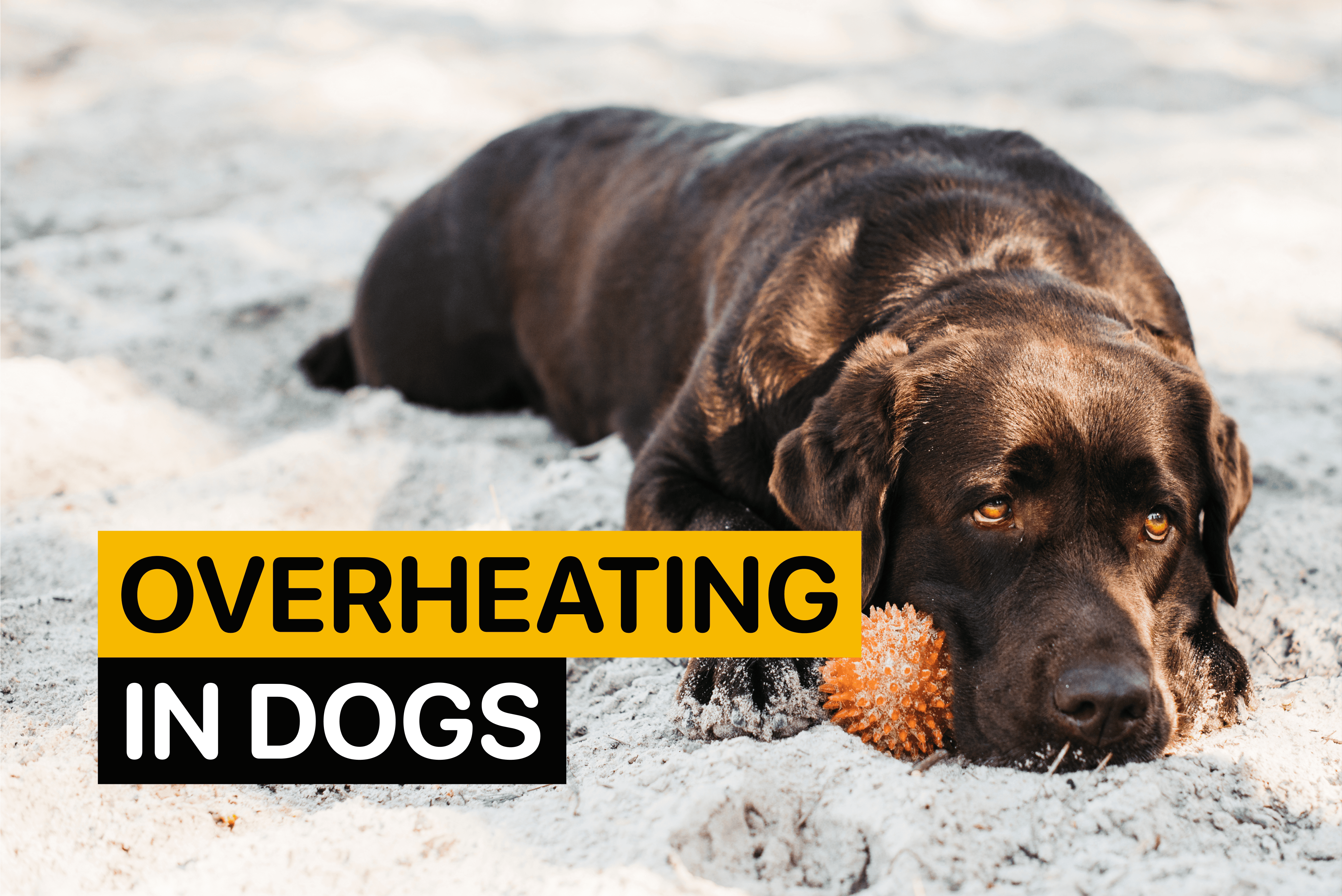What Temperature Is Too Hot to Walk a Dog? Safe Temperature Guide

By
Woofz Team Updated on |Reviewed by
Karen PiwinskiSummer is here, bringing longer days and increased opportunities for daily walks and mental stimulation outdoors. However, almost every year, we face record-breaking temperatures that are dangerous not only for people but also for our pets. As a responsible pet parent, you may face a dilemma: how can I ensure my dog’s needs are met during daily walks while keeping them safe in boiling weather? Is it ever too hot to walk a dog?
Walking a dog in the summer heat can be a challenging experience. Let’s explore the topic further and learn how to make it as safe as possible and keep your dog cool.
What Temp Is Too Hot to Walk a Dog?
When talking about what temperature is considered dangerous for a canine outside, it’s not a “one-size-fits-all” situation. We must consider a range of factors that affect how hot your pet feels. They include your dog’s breed, coat length and density, age, and weight. Environmental factors we must consider include the temperature of the pavement, the humidity level, and the intensity of physical exercise to which you expose your furry friend.

What temperature is safe for dogs?
Generally, we can treat any temperature at or above 85°F (29°C) as drastically increasing the risk of overheating. Individual tolerance to high temperatures in canines varies. Although, for the majority of dog parents, a temperature of more than 82°F (28°C) requires paying closer attention to their pet's tolerance. Some breeds may feel the negative impact of heat even at moderate temperatures as low as 70°F (21°C).

When it comes to lower temperatures, anything below 45°F (7°C) can be considered dangerous. However, it’s worth mentioning that short-coated breeds can feel the detrimental effects of cold when the temperature drops below 50°F (10°C). Consider the potential effects if a dog stays in the described conditions for more than 4 hours.
On average, it’s safe for a canine to stay outdoors if the temperature is between 45°F (7°C) – 85°F (29°C).
What temperature is dangerous for dogs outside?
Canines are among the pets that suffer the most during heat waves due to prolonged exposure to high temperatures. According to Kimberly Lutz, DVM CVMA, an associate veterinarian at Craig Road Animal Hospital, around 50% of heat stroke cases turn out to be lethal. So, pet temperature regulations shouldn’t be taken lightly.

The variations in temperature outside, between 68°F (20°C) and 86°F (30°C), are safe for healthy canines. Temperatures above 90°F (32°C) require owners to keep their pets indoors. If your dog spends time outdoors during a heatwave, they must have constant access to clean and cold water and shelter to hide from direct sunlight.
How hot is too hot for a dog to be inside the house?
The Animal Welfare Act (AWA) specifies temperature requirements for housing pets. According to this, dogs shouldn’t spend more than 4 hours in temperatures of 85°F (29°C), as this poses a risk of heat stroke. Their housing should also be equipped with a ventilation or air-conditioning system to reduce the temperature if it rises above this limit. Ventilation, however, doesn’t mean you can allow the temperature to rise above the maximum of 85°F (29°C).
Dangerous pavement temp for dogs
Another critical thing to consider when taking a dog for a walk in summer is the pavement (asphalt or concrete), as it becomes extremely hot under direct sunlight and can cause burns to a canine's sensitive skin on their pads.

That’s why pet parents should assess the pavement temperature before allowing their pooch to step on it. A simple yet effective way is to place your palm on the pavement for around 7 seconds. If you feel comfortable doing that, the pavement is safe to walk on.
How Long to Walk a Dog in Hot Weather?
To better understand the ideal weather conditions for walking your pooch outside, it's essential to understand the heat index. The heat index combines the effects of humidity and temperature in the environment. It’s vital to pay attention to the humidity level, as humid air makes panting less effective, so canines struggle to cool themselves down effectively.
To determine the safe heat index for dogs, combine the outdoor temperature (in Fahrenheit) and humidity level. If the number is higher than 150, don’t take your pet outside.
Heat Index = Temperature 85°F + Humidity 80% = 165
TOO DANGEROUS TO WALK A DOG
Suppose the heat index poses a moderate risk for your pet. When is it too hot to walk your dog outside? Let’s break down the approximate time limitations for outdoor activities when it’s hot.

Note, however, that these are approximate estimations of proper walking time in hot weather. These numbers can vary depending on your dog’s size, age, breed, medical history, and individual tolerance to heat. Another critical factor is the activity level – the more intense the exercise, the less time a dog should spend outdoors.
What Are Signs Your Dog Is Too Hot?
The core body temperature in canines is higher (101°F–102.5°F or 38°C–39 °C) than that of humans. No wonder it’s so much quicker for a dog to get overheated. To prevent overheating, a responsible pet owner should be aware of signs indicating their pooch is suffering from the hot sun.
Your dog is too hot when:

- They pant and drool excessively
- Their gums turn bright red or blue or appear bruised
- The gum tissue is dry
- They vomit or have a seizure
- They seem weak, lethargic, and disoriented
- Rectal body temperature is high (above 104°F or 40°C).
These signs can indicate heat stress or heat stroke, the latter of which is a medical emergency that requires immediate veterinary attention. While waiting for an overheated dog to be transported to a vet, try to cool them down at home by taking them to a cool spot (you can use cooling mats, cool but not cold wet towels, or even ice cubes), offering water to drink, and gently pouring cool water on their body to lower their body temperature.
Walking a Dog in Hot Weather: What to Consider
Walking your furry companion during hot days can be less dangerous if you take some precautions. The key to keeping your dog safe is to meticulously plan your walks to avoid or minimize situations that could lead to heat stroke. Here are some suggestions.
1. Adjust the time and routes of your walks

Stroll in areas with plenty of shade and grass (remember, asphalt and concrete get hot too). Avoid walking for prolonged periods or exercising your pooch in the summer. Plan your walks to go outdoors in the early morning or late at night when the temperature is cooler outside.
2. Take enough water with you
Keeping your dog hydrated is a must. Canines pant more than usual in hot weather, which can lead to dehydration. Always bring a bottle of fresh water with you to offer to your pet during the walks. You can use a collapsible bowl to pour water when you're far from home or to cool your dog's body temperature.
3. Never leave your dog alone in a hot car

Cars can get extremely hot, so leaving your pet in there when you step away, even for a few minutes, can be fatal. If you need to travel by car with your dog when it’s hot, cool the car down with the air conditioning before letting them in.
4. Use paw protection
Although walking in parks is preferable during a heatwave, you may face a situation when it’s necessary to stroll along an asphalt pavement. In this case, you must protect your dog’s paws to avoid damaging the sensitive skin on their pads. Use special dog booties and apply paw balm to ensure an extra layer of protection.
5. Mind the humidity level
It’s not uncommon for dogs to pant excessively on hot days.

Panting serves as a natural mechanism for dogs to cool themselves down, as they evaporate moisture from their lungs and decrease their body temperature. High humidity can interfere with the process and make panting less effective, leading to overheating or even heat stroke.
6. Consider your dog’s age and breed
Both breed and age are crucial factors to consider when taking a pet outside in boiling weather. For example, pugs and bulldogs have difficulty tolerating extreme heat due to the unique structure of their skulls (they are flat-faced dogs). Additionally, thick-coated breeds are more prone to overheating in the summer.
When it comes to age, young pups and senior dogs are more prone to overheating when it’s scorching outside. Therefore, you should arrange the walks in a way that allows them to avoid direct sunlight and rest in shaded areas.
7. Monitor the signs of heat stroke
Heat stroke is a life-threatening condition for canines.

If you choose to take your dog outdoors in hot weather, keep a close eye on them and check for signs of heat stroke. If your pet appears to be lacking energy, pants excessively, or starts vomiting, take them inside to a cool, well-ventilated area (with the air conditioning on) and consult your vet as soon as possible.
Wrap Up
Summer is an excellent opportunity for pet parents and their furry companions to spend more quality time outside. However, this season can also pose a risk to your dog’s life and health, especially if you walk them in hot weather. Stick to the norms and regulations on comfortable weather conditions for your pet to ensure their safety.


